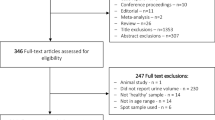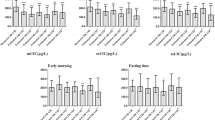Abstract
Urinary iodine concentration (UIC) is commonly used to assess iodine status of subjects in epidemiological surveys. As pre-analytical factors are an important source of measurement error and studies about this phase are scarce, our objective was to assess the influence of urine sampling conditions on UIC, i.e., whether the child ate breakfast or not, urine void rank of the day, and time span between last meal and urine collection. A nationwide, two-stage, stratified, cross-sectional study including 1560 children (6–12 years) was performed in 2012. UIC was determined by the Sandell-Kolthoff method. Pre-analytical factors were assessed from children’s mothers by using a questionnaire. Association between iodine status and pre-analytical factors were adjusted for one another and socio-economic characteristics by multivariate linear and multinomial regression models (RPR: relative prevalence ratios). Skipping breakfast prior to morning urine sampling decreased UIC by 40 to 50 μg/L and the proportion of UIC < 100 μg/L was higher among children having those skipped breakfast (RPR = 3.2[1.0–10.4]). In unadjusted analyses, UIC was less among children sampled more than 5 h from their last meal. UIC decreased with rank of urine void (e.g., first vs. second, P < 0.001); also, the proportion of UIC < 100 μg/L was greater among 4th rank samples (vs. second RPR = 2.1[1.1–4.0]). Subjects’ breakfast status and urine void rank should be accounted for when assessing iodine status. Providing recommendations to standardize pre-analytical factors is a key step toward improving accuracy and comparability of survey results for assessing iodine status from spot urine samples. These recommendations have to be evaluated by future research.

Similar content being viewed by others
References
Haynes RB (1997) Nature and role of observational studies in public health policy concerning the effects of dietary salt intake on blood pressure. Am J Clin Nutr 65:622S–625S
Rothman KJ, Greenland S, Lash TL (2008) Modern epidemiology, 3rd edn. Lippincott Williams & Wilkins, Philadelphia
Green SF (2013) The cost of poor blood specimen quality and errors in preanalytical processes. Clin Biochem 46:1175–1179. https://doi.org/10.1016/j.clinbiochem.2013.06.001
Kanagasabapathy A, Kumari S (2000) Guidelines on standard operating procedures for clinical chemistry. World Health Organization, Geneva
Kellogg MD, Ellervik C, Morrow D, Hsing A, Stein E, Sethi AA (2015) Preanalytical considerations in the design of clinical trials and epidemiological studies. Clin Chem 61:797–803. https://doi.org/10.1373/clinchem.2014.226118
Aliasgharpour M (2016) The pre analytical phase: precautions in specimen collection and patient preparation for trace and ultra trace elements analysis. Int J Med Investig 5:139–145
Collery P, Bratter P, De Bratter VN et al (1998) Ions Métalliques en Biologie Et en Médecine: Cinquième Symposium International Sur Les Ions Métalliques en Biologie Et en Médecine (8–10 Mai 1998). John Libbey Eurotext, Neuherberg-Munich, Allemagne
Burtis CA, Ashwood ER, Bruns DE (2012) Tietz textbook of clinical chemistry and molecular diagnostics, 5th edn. Elsevier Health Sciences, Missouri
International Council for Control of Iodine Deficiency Disorders, United Nations Children's Fund & World Health Horganization (2007) Assessment of iodine deficiency disorders and monitoring their elimination: a guide for programme managers, 3rd edn. World Health Organization, Geneva
Zimmermann MB, Andersson M (2012) Update on iodine status worldwide. Curr Opin Endocrinol Diabetes Obes 19:382–387. https://doi.org/10.1097/MED.0b013e328357271a
Ma ZF, Skeaff SA (2017) Assessment of population iodine status. In: Pearce EN (ed) Iodine deficiency disorders and their elimination. Springer international publishing, Cham, pp 15–28
Soldin OP (2002) Controversies in urinary iodine determinations. Clin Biochem 35:575–579. https://doi.org/10.1016/S0009-9120(02)00406-X
Busnardo B, Nacamulli D, Zambonin L, Mian C, Piccolo M, Girelli ME (2006) Restricted intraindividual urinary iodine concentration variability in nonfasting subjects. Eur J Clin Nutr 60:421–425. https://doi.org/10.1038/sj.ejcn.1602334
Andersen SL, Sorensen LK, Krejbjerg A et al (2014) Challenges in the evaluation of urinary iodine status in pregnancy: the importance of iodine supplement intake and time of sampling. Eur Thyroid J 3:179–188. https://doi.org/10.1159/000365145
Doggui R, El Atia J (2015) Iodine deficiency: physiological, clinical and epidemiological features, and pre-analytical considerations. Ann Endocrinol (Paris) 76:59–66. https://doi.org/10.1016/j.ando.2014.12.002
Doggui R, El Ati-Hellal M, Traissac P et al (2017) Adequacy assessment of a universal salt iodization program two decades after its implementation: a national cross-sectional study of iodine status among school-age children in Tunisia. Nutrients 9 9:6. https://doi.org/10.3390/nu9010006
Doggui R, El Ati-Hellal M, El Ati J (2016) Données actuelles sur l’analyse de l’iode urinaire et sur son intérêt clinique. Ann Biol Clin (Paris) 74:184–195. https://doi.org/10.1684/abc.2016.1124
Zimmermann MB, Aeberli I, Andersson M, Assey V, Yorg JAJ, Jooste P, Jukić T, Kartono D, Kusić Z, Pretell E, San Luis TOL Jr, Untoro J, Timmer A (2013) Thyroglobulin is a sensitive measure of both deficient and excess iodine intakes in children and indicates no adverse effects on thyroid function in the UIC range of 100-299 mug/L: a UNICEF/ICCIDD study group report. J Clin Endocrinol Metab 98:1271–1280. https://doi.org/10.1210/jc.2012-3952
Als C, Helbling A, Peter K, Haldimann M, Zimmerli B, Gerber H (2000) Urinary iodine concentration follows a circadian rhythm: a study with 3023 spot urine samples in adults and children. J Clin Endocrinol Metab 85:1367–1369. https://doi.org/10.1210/jcem.85.4.6496
Rasmussen LB, Ovesen L, Christiansen E (1999) Day-to-day and within-day variation in urinary iodine excretion. Eur J Clin Nutr 53:401–407
Christiansen TB, Lauritsen JM (2008) EpiData data entry, data management and basic statistical analysis system. The EpiData Association, Odense
StataCorp (2015) Stata statistical software: release. College Station, StataCorp LP, TX, p 14
Zimmermann MB (2008) Methods to assess iron and iodine status. Br J Nutr 99(Suppl. 3):S2–S9. https://doi.org/10.1017/S000711450800679X
Preedy VR, Burrow GN, Watson RR (2009) Comprehensive handbook of iodine: nutritional, biochemical, pathological and therapeutic aspects. Elsevier Science, Burlington
Thomson CD, Colls AJ, Conaglen JV, Macormack M, Stiles M, Mann J (1997) Iodine status of New Zealand residents as assessed by urinary iodide excretion and thyroid hormones. Br J Nutr 78:901–912. https://doi.org/10.1079/BJN19970208
Thomson CD, Packer MA, Butler JA, Duffield AJ, O'Donaghue KL, Whanger PD (2001) Urinary selenium and iodine during pregnancy and lactation. J Trace Elem Med Biol 14:210–217. https://doi.org/10.1016/S0946-672X(01)80004-3
Vejbjerg P, Knudsen N, Perrild H, Laurberg P, Andersen S, Rasmussen LB, Ovesen L, Jørgensen T (2009) Estimation of iodine intake from various urinary iodine measurements in population studies. Thyroid 19:1281–1286. https://doi.org/10.1089/thy.2009.0094
Zimmermann MB (2009) Iodine deficiency. Endocr Rev 30:376–408. https://doi.org/10.1210/er.2009-0011
Jeyabalan A, Conrad KP (2007) Renal function during normal pregnancy and preeclampsia. Front Biosci 12:2425–2437. https://doi.org/10.2741/2244
Perrine CG, Cogswell ME, Swanson CA, Sullivan KM, Chen TC, Carriquiry AL, Dodd KW, Caldwell KL, Wang CY (2014) Comparison of population iodine estimates from 24-hour urine and timed-spot urine samples. Thyroid 24:748–757. https://doi.org/10.1089/thy.2013.0404
Wang CY, Cogswell ME, Loria CM, Chen TC, Pfeiffer CM, Swanson CA, Caldwell KL, Perrine CG, Carriquiry AL, Liu K, Sempos CT, Gillespie CD, Burt VL (2013) Urinary excretion of sodium, potassium, and chloride, but not iodine, varies by timing of collection in a 24-hour calibration study. J Nutr 143:1276–1282. https://doi.org/10.3945/jn.113.175927
Cornelis R, Heinzow B, Herber RF et al (1996) Sample collection guidelines for trace elements in blood and urine. IUPAC Commission of Toxicology J Trace Elem Med Biol 10:103–127. https://doi.org/10.1016/S0946-672X(96)80018-6
Andersen S, Karmisholt J, Pedersen KM, Laurberg P (2008) Reliability of studies of iodine intake and recommendations for number of samples in groups and in individuals. Br J Nutr 99:813–818. https://doi.org/10.1017/S0007114507842292
Barnett AG, van der Pols JC, Dobson AJ (2005) Regression to the mean: what it is and how to deal with it. Int J Epidemiol 34:215–220. https://doi.org/10.1093/ije/dyh299
Konig F, Andersson M, Hotz K et al (2011) Ten repeat collections for urinary iodine from spot samples or 24-hour samples are needed to reliably estimate individual iodine status in women. J Nutr 141:2049–2054. https://doi.org/10.3945/jn.111.144071
Funding
The work was supported by the Tunisian National Institute of Nutrition and Food Technology of the Tunisian Ministry of Health and by grants from the United Nations Children’s Fund (UNICEF) Tunisia.
Author information
Authors and Affiliations
Corresponding author
Ethics declarations
Conflict of Interest
The authors declare that they have no conflicts of interest.
Ethical Approval
All procedures performed in studies involving human participants were in accordance with the ethical standards of the institutional and/or national research committee and with the 1964 Helsinki declaration and its later amendments or comparable ethical standards.
Informed Consent
Written informed consent was obtained from all individual participants included in the study.
Rights and permissions
About this article
Cite this article
Doggui, R., El Ati-Hellal, M., Traissac, P. et al. Pre-analytical Factors Influence Accuracy of Urine Spot Iodine Assessment in Epidemiological Surveys. Biol Trace Elem Res 186, 337–345 (2018). https://doi.org/10.1007/s12011-018-1317-y
Received:
Accepted:
Published:
Issue Date:
DOI: https://doi.org/10.1007/s12011-018-1317-y




